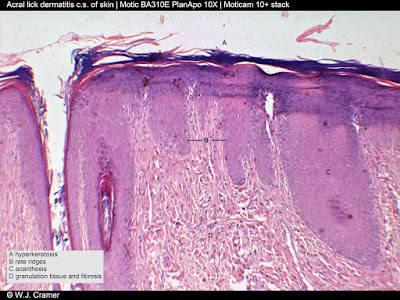The first symptoms are discoloration of the coat due to the saliva. The skin can become thicker and bald. Inflammation of the skin is possible due to the granuloma. This starts itching more and makes the dog more lick and bite. Then the dog comes in a vicious circle. The process can continue down to the bone, sometimes amputation is necessary. A lick granuloma actually only occurs on the front legs.
The diagnosis is fairly easy. A lot of licking and the symptoms are often sufficient to make the diagnosis. Underlying causes should be excluded, for example with an X-ray to see if there are abnormalities in the bone that can cause obsessive licking.
Letting the dog stop is difficult! It has become a habit and that is difficult to break. Go for a walk with them. Another possibility is to put a sock over a leg or a collar. In the past there have been legs amputated to stop this. Nowadays this is no longer done. This is not necessary due to better treatment options. If there are inflammations, this should be treated, possibly with antibiotics (ointment or in bad cases tablets) A skin ointment can bring relief, but the dog often licks it off. Itching-relieving injections are sometimes also possible.
Letting the dog stop is difficult! It has become a habit and that is difficult to break. Go for a walk with them. Another possibility is to put a sock over a leg or a collar. In the past there have been legs amputated to stop this. Nowadays this is no longer done. This is not necessary due to better treatment options. If there are inflammations, this should be treated, possibly with antibiotics (ointment or in bad cases tablets) A skin ointment can bring relief, but the dog often licks it off. Itching-relieving injections are sometimes also possible.
Indicated on the microscopic images:
B - RETE RIDGES: These are epithelial protrusions into the underlying connective tissue.
C - ACANTHOSIS OR ACANTHOSIS NIGRICANS: Increase in the number of cell layers in the epidermis, with a black discoloration as can be seen in the specimen.
D - GRANULATION TISSUE* & FIBROSIS*: The dermis is thickened by granulation tissue and fibrosis.
______________________________________________________________
* Hyperkeratosis: Thickening of the top layer of the skin
** Granulation tissue: New tissue formed during the healing process of a wound
*** Fibrosis: Formation of excess fibrous connective tissue
** Granulation tissue: New tissue formed during the healing process of a wound
*** Fibrosis: Formation of excess fibrous connective tissue
With thanks to Cees Koopman, veterinarian.




No comments:
Post a Comment